Nestled amidst the emerald embrace of the Sahyadri ranges in Maharashtra, Lonavala and Khandala emerge as twin hill stations, beckoning travelers with their captivating charm and refreshingly pleasant climate. Just a quick drive from Mumbai and Pune, these picturesque escapes have long been a haven for nature lovers, adventure seekers, and weary city dwellers yearning for a breath of fresh air.
Lonavala enchants with its cascading waterfalls, serene lakes, and verdant hillsides that dance with misty clouds. Khandala, on the other hand, captivates with its dramatic viewpoints offering panoramic vistas of deep valleys. Ancient caves, steeped in history, whisper tales of a bygone era. Together, they form a harmonious duo, offering a symphony of natural beauty, thrilling outdoor activities, and unique cultural experiences that epitomize the magic of the Western Ghats.
How to reach:
Taking Flight:
- Closest Connection: Pune Airport (PNQ) sits roughly 65 kilometers away, offering domestic flights from major Indian cities. Taxis and buses are readily available to whisk you to your hill station haven.
- Alternative Gateway: Chhatrapati Shivaji Maharaj International Airport (BOM) in Mumbai is another option, though slightly farther at 100 kilometers. From here, a taxi or train to Pune connects you to Lonavala and Khandala.
Train Travel:
- Convenient Connections: Both Lonavala and Khandala boast their own railway stations, well-linked to Mumbai and Pune. Numerous trains ply this route, showcasing the scenic beauty of the Western Ghats. Expect a journey of 2-3 hours from Mumbai and a shorter 1-1.5 hours from Pune.
Road Trip Options:
- Mumbai to the Hills: The Mumbai-Pune Expressway (NH 48) offers a convenient 80-kilometer route from Mumbai, with a travel time of around 2 hours depending on traffic.
- Pune Getaway: Lonavala lies approximately 65 kilometers from Pune, accessible via the same Mumbai-Pune Expressway. The drive or bus ride takes roughly 1.5-2 hours.
Public Buses:
- Maharashtra State Road Transport Corporation (MSRTC): Look for regular buses connecting Mumbai, Pune, and Lonavala. For a more comfortable journey, consider private buses or taxis.
Best time to visit:
Winters (October – February): Escape the city’s clamor and embrace the cool embrace of winter in Lonavala and Khandala. Perfect weather for adventure awaits, with temperatures ranging from 12°C to 25°C. Hike misty hills, explore viewpoints like Tiger Point and Duke’s Nose, or marvel at the cascading splendor of Bhushi Dam and Kune Falls. Clear skies and comfortable temperatures make it an ideal time to soak in the natural beauty. Festive cheer during Diwali and Christmas adds a touch of cultural charm to your serene escape.
Monsoon (June – September): The monsoon transforms Lonavala and Khandala into a verdant paradise. Lush greenery unfolds with heavy rains, rejuvenating waterfalls and hillsides. Witness Bhushi Dam and Lonavala Lake come alive, offering breathtaking waterfalls and a tranquil ambiance. While trekking might be limited due to rain, the season unveils the region’s natural beauty at its peak.
Summers (March – May): Summer brings mild to moderate temperatures (22°C to 36°C) ideal for exploring historical and cultural gems. Delve into the ancient wonders of Karla and Bhaja Caves, showcasing intricate Buddhist carvings. Evenings offer cooler temperatures perfect for strolls at Sunset Point or indulging in local delicacies like chikki. With fewer crowds compared to peak seasons, summer offers a tranquil escape amidst the Western Ghats’ scenic beauty.
Attractions:
Lonavala:
Tiger’s Leap (Tiger Point):
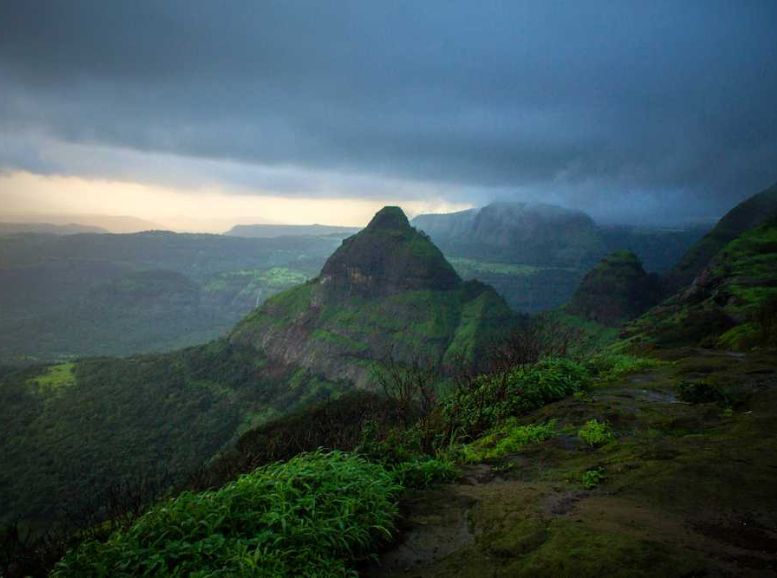
Soar above the ordinary at Tiger’s Leap, Lonavala’s most iconic viewpoint. Perched a staggering 650 meters high, this aptly named spot offers panoramic vistas that will leave you breathless. Gaze out at the lush tapestry of the Western Ghats, their valleys plunging dramatically below. The name itself sparks the imagination – a tiger, frozen mid-leap across the vast expanse.
The magic truly unfolds during the monsoon. Imagine the scene: emerald hills swathed in mist, clouds clinging playfully to the peaks, and the entire landscape washed clean by refreshing rain.
Bhushi Dam:
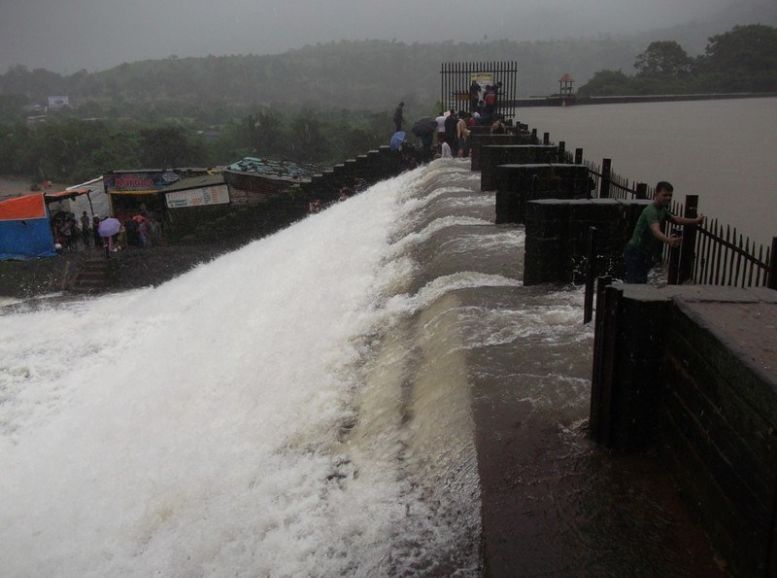
Nestled amidst Lonavala’s scenic beauty, Bhushi Dam beckons with its serene charm and a unique monsoon transformation. Built on the Indrayani River, the dam creates a reservoir that comes alive during the rainy season. Cascading waterfalls overrun the steps and rocky terrain, creating a natural waterpark. The sound of gushing water fills the air, both soothing and exhilarating. Visitors can cool off by sitting on the steps and letting the cool water flow over them.
Beyond the monsoon magic, Bhushi Dam offers a year-round escape. Lush greenery surrounds the dam, creating a picture-perfect setting for picnics and leisurely strolls.
Rajmachi Point:
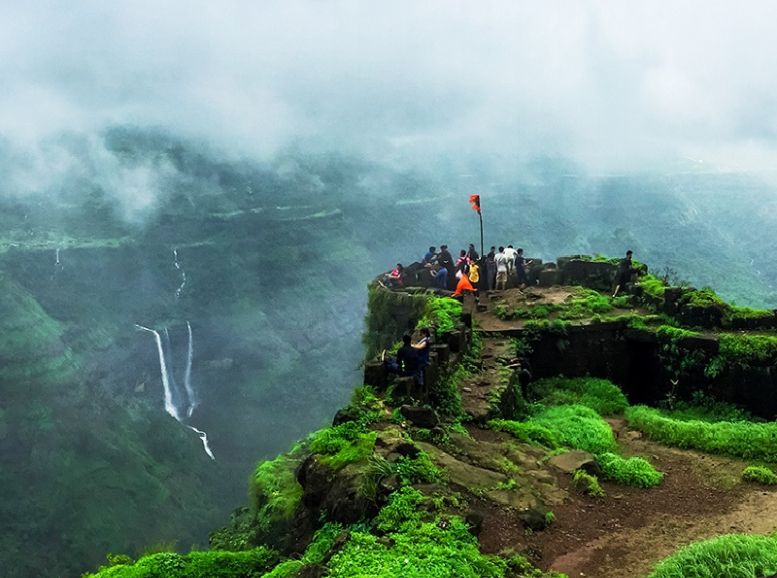
Unfurl a breathtaking panorama at Rajmachi Point, Lonavala’s treasure trove of scenic vistas. Gaze upon the majestic Rajmachi Fort, its silhouette etched against the verdant embrace of the Sahyadri mountains. Lush valleys unfurl below, whispering tales of the Western Ghats’ grandeur.
This haven of tranquility is a favorite among travelers seeking a break from the ordinary. Imagine arriving as the first rays of dawn paint the sky in fiery hues, bathing the landscape in a magical golden glow.
Khandala:
Duke’s Nose (Nagphani):
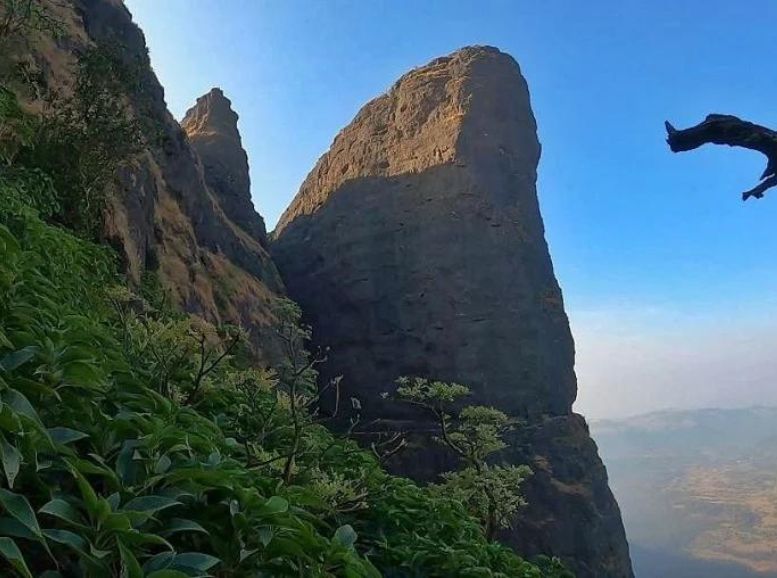
Soaring above Khandala, Duke’s Nose (or Nagphani to the locals, named for its serpentine shape) is a cliff-turned-legend. At a staggering 750 meters, it offers panoramic vistas that will leave you speechless. Imagine lush valleys sprawling beneath you, the Western Ghats guarding the horizon, and winding roads like ribbons tracing the landscape.
This isn’t just a scenic wonder; it’s an adventurer’s paradise. Duke’s Nose beckons with thrilling activities like trekking, rock climbing, and rappelling. The moderately challenging trek leads you through dense forests and rocky terrains, culminating in a breathtaking reward at the summit.
Bhaja Caves, Lonavala and Khandala:
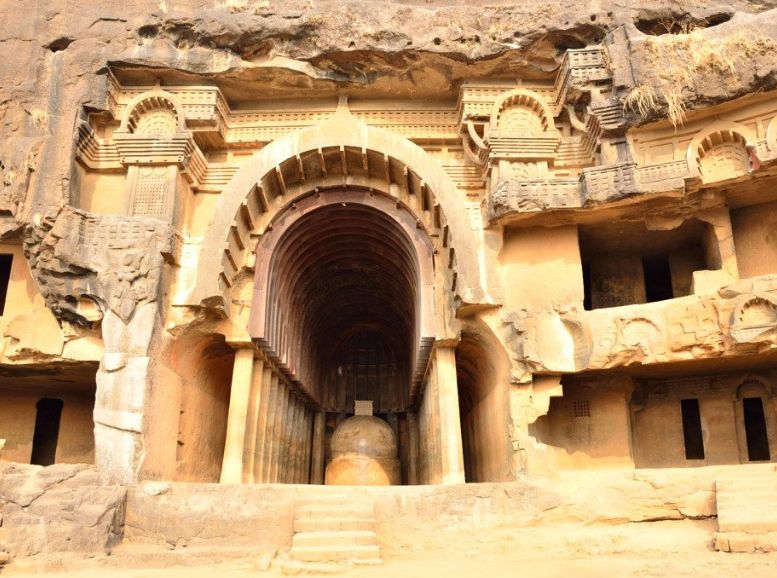
Journey back in time at the Bhaja Caves in Khandala. Carved from the rugged cliffs in the 2nd century BC, these 22 Buddhist caves stand as testaments to a rich cultural heritage. Step inside and marvel at the intricate carvings, stupas (hemispherical structures), and chaityas (prayer halls) – each whispering tales of Buddhist monks and their devotion.
A marvel of ancient engineering, the main chaitya hall boasts a dramatic horseshoe-shaped entrance and a ribbed roof that seems to defy gravity. Imagine the flickering light of oil lamps illuminating these intricate carvings, creating a truly mesmerizing spectacle.
Kune Falls:
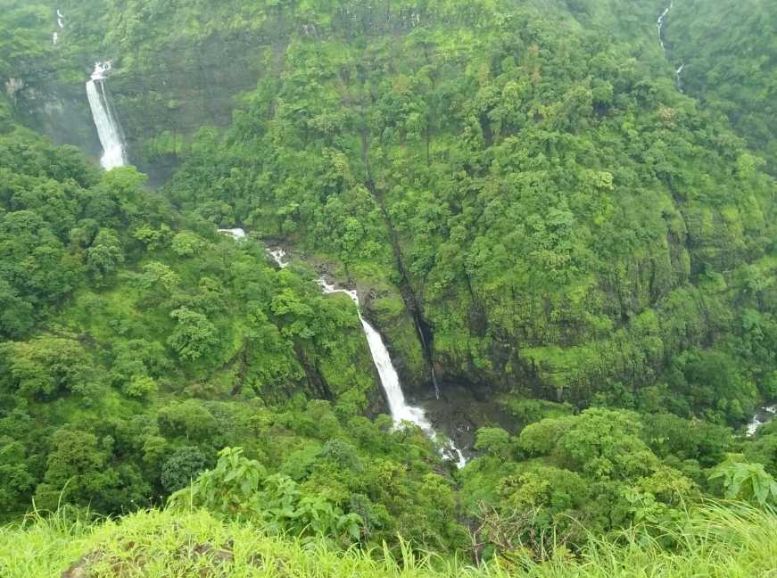
Nestled between Lonavala and Khandala lies Kune Falls, a crown jewel of cascading beauty. As the 14th highest waterfall in India, its 200-meter plunge carves a dramatic descent through a verdant valley. Divided into three tiers, the falls erupt in a magnificent display, especially during the monsoon when the gushing water creates a refreshing mist.
Nature lovers rejoice! The area surrounding Kune Falls is a haven for picnics, scenic treks, and capturing breathtaking photographs. The serene environment offers a perfect escape from the city’s clamor.
Local Experiences:
History Whispers: Delve into the past at the Karla and Bhaja Caves, marveling at ancient Buddhist architecture and intricate carvings. Hike or trek to historic forts like Rajmachi and Lohagad, offering panoramic vistas and whispers of bygone eras.
Nature’s Playground: Embrace the monsoon magic at Bhushi Dam, where cascading waterfalls create a natural waterpark. Witness the cascading wonder of Kune Falls, one of India’s highest. Take in breathtaking sunrises and sunsets from Tiger Point, or embark on an adventure with treks to Duke’s Nose and Rajmachi Fort.
Outdoor Adventures: Challenge yourself with rock climbing and rappelling at Duke’s Nose. Explore scenic trails, or simply relax with a picnic by the serene Lonavala Lake.
A Culinary Journey: Indulge in local favorites like chikki, a sweet treat made with jaggery and nuts. Savor the vibrant flavors of vada pav and bhajiyas, or treat yourself to a traditional Maharashtrian thali.
Leisurely Delights: Stroll through the scenic gardens of Ryewood Park or explore lifelike wax figures at the Lonavala Wax Museum. Unwind and rejuvenate at one of the many spas and wellness centers.
Travel tips:
- Dress for the Season: Layers are key for cooler winters, while light and breathable clothing is ideal for summers.
- Comfy Shoes: Sturdy, comfortable shoes are essential for exploring on foot.
- Taxis for Convenience: Taxis or car rentals offer convenient transportation, especially if you’re unfamiliar with the area.
- Local Options: Auto-rickshaws and buses provide affordable options for shorter distances. Always agree on the fare beforehand.
- Hydration is Key: Carry a reusable water bottle and stay hydrated, particularly during hikes and outdoor activities.
- Be Prepared: Pack essential medications, including motion sickness remedies if needed.
- Respect the Wildlife: Avoid feeding monkeys at tourist spots, as they can become aggressive.
- Respect the Culture: Dress modestly, especially at religious sites and when interacting with locals.
- Keep it Clean: Dispose of waste properly to preserve the region’s natural beauty.
- Cash is King: While many places accept cards, smaller shops and vendors might prefer cash.
- ATMs for Back-Up: ATMs are available, but carrying enough cash for immediate needs is advisable.
- Map it Out: Create an itinerary to maximize your time and explore must-see attractions.
- Beat the Crowds: Start your day early to avoid crowds and enjoy a peaceful experience.
- Weather Check: Always check the forecast before venturing out, especially for outdoor activities and treks.
- Sample Street Food: Explore local delicacies like chikki, vada pav, and bhajiyas from reputable stalls for an authentic taste.
- Local Eats: Indulge in traditional Maharashtrian cuisine at local restaurants.
- Safety First: Ensure you have the right gear and follow safety guidelines for activities like trekking, rock climbing, and rappelling.
- Expert Guidance: Consider hiring a local guide for treks or adventure sports to enhance your experience and ensure safety.
- Mobile Coverage: Most areas have good mobile network coverage, but some remote locations might have weak signals.
- Internet on the Go: Wi-Fi is available at most hotels and cafes. Consider a local SIM card with a data plan for seamless connectivity.
- Bargaining Tips: Bargaining is common practice in local markets, but do so politely.
- Support Local Artisans: Take home unique souvenirs, handcrafted items, and local specialties like chikki and fudge.
Conclusion
Unwind amidst the magic of Lonavala and Khandala, nestled within the Western Ghats. Explore Xplro.com to craft your escape – these captivating twin hill stations offer cascading waterfalls, ancient Buddhist caves, and panoramic vistas for trekkers, history buffs, and foodies alike. Ideal for a quick weekend getaway from Mumbai or Pune or a longer exploration, Xplro.com can guide you through the vibrant landscapes of the monsoon, the pleasant sightseeing opportunities of winter, or the serene tranquility of summer.
FAQs
What is the suggested for to visit Lonavala and Khandala?
- The ideal time to visit Lonavala and Khandala is during the winter months, from October to February, when the weather is cool and pleasant. The monsoon season, from June to September, is also a great time to experience the lush greenery and waterfalls.
2. How do I reach Lonavala and Khandala?
- Lonavala and Khandala are well-connected by road, rail, and air. They are accessible from Mumbai (83 km) and Pune (65 km) via the Mumbai-Pune Expressway. The nearest railway station is Lonavala, and Pune International Airport is the closest airport.
3. What are the top attractions in Lonavala and Khandala?
- Must-see attractions include Tiger’s Leap, Bhushi Dam, Karla and Bhaja Caves, Rajmachi Point, Duke’s Nose, Kune Falls, and Amrutanjan Point, offering stunning views, historical insights, and natural beauty.
4. Are there any adventure activities available in Lonavala and Khandala?
- Yes, visitors can enjoy trekking, rock climbing, rappelling, and camping. Popular spots for these activities include Duke’s Nose, Rajmachi Fort, and Lohagad Fort.
5. What should I pack for a trip to Lonavala and Khandala?
- Pack comfortable clothing, sturdy shoes for trekking, rain gear if visiting during the monsoon, a hat, sunglasses, sunscreen, and personal medications. Layered clothing is recommended for cooler winter months.
6. Is it safe to visit Lonavala and Khandala?
- Generally, Lonavala and Khandala are safe for tourists. Standard safety precautions should be followed, especially during monsoon when trails can be slippery. Be cautious of wildlife like monkeys and avoid feeding them.
7. What local foods should I try in Lonavala and Khandala?
- Sample local delicacies like chikki (a sweet made from jaggery and nuts), vada pav, bhajiyas, and traditional Maharashtrian thali. Many local eateries offer these delicious foods.
8. Are there good accommodation options in Lonavala and Khandala?
- Yes, there are various accommodation options ranging from budget hotels to luxury resorts. It’s advisable to book in advance, especially during peak tourist seasons and weekends.
9. Can I visit Lonavala and Khandala in one day?
- While it is possible to visit both places in a single day due to their proximity, staying for at least 2-3 days is recommended to fully explore and enjoy the attractions and activities.
10. What are some good spots for photography in Lonavala and Khandala?
- Excellent spots for photography include Tiger’s Leap, Rajmachi Point, Duke’s Nose, Bhushi Dam, and Kune Falls, offering stunning vistas perfect for capturing the natural beauty of the region.
11. Is there public transportation available in Lonavala and Khandala?
- Yes, auto-rickshaws and local buses are available for short distances. However, hiring a taxi or renting a car is recommended for convenience and flexibility, especially for visiting multiple attractions.
12. Are there any festivals or events in Lonavala and Khandala?
- Yes, the Khandala Festival in February features cultural performances, local cuisine, and various activities. Additionally, visiting during Diwali and Christmas can be enjoyable due to the festive atmosphere.





